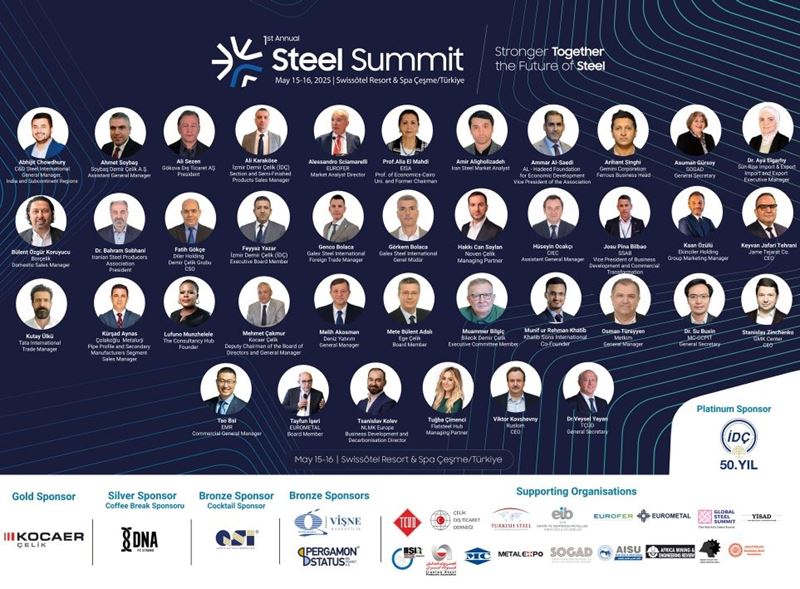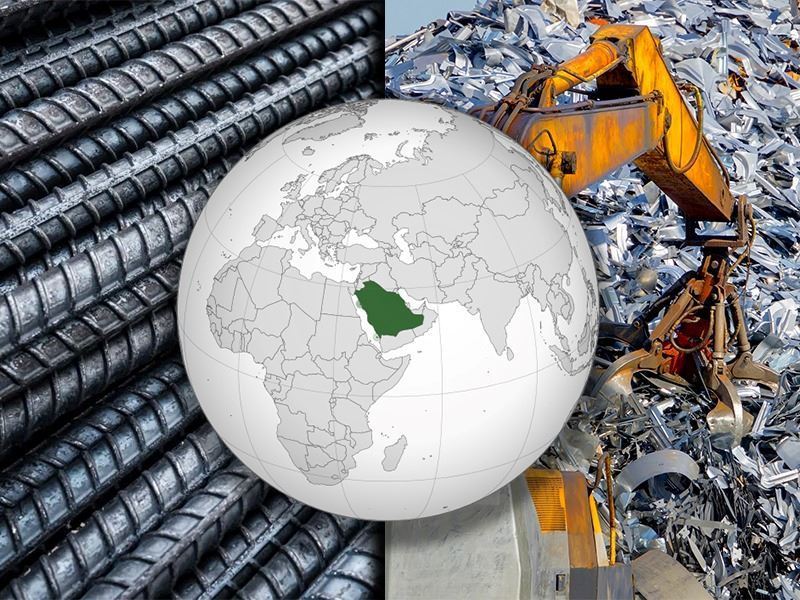Tuğba Çimenci, who will also make important evaluations on the Green Steel Panel at the Steel Summit 2025 conference, shared critical information on the EU's Carbon Border Adjustment Mechanism (CBAM), green transformation targets, carbon footprint reporting, vulnerabilities in the supply chain and EU-Türkiye trade relations. Çimenci explained in detail how Turkish manufacturers can adapt to these new regulations and how important the strategic steps to be taken in this process are.
What do you think about the impact of the EU's Steel Action Plan on the industry? What opportunities and challenges might this plan create for Turkish steel producers and exporters?
The EU's Steel and Metals Action Plan, published in March 2025, represents an important step in Europe's industrial strategy in terms of green transformation and strategic autonomy. The main objectives of the plan include reducing carbon emissions, increasing the proportion of recycled content, strategizing scrap resources and encouraging a transition to energy-efficient, low-carbon production.
This plan means both transformation pressure and market opportunity for the Turkish steel industry. In particular, the European Union's phased implementation of carbon-based trade regulations such as CBAM has rapidly brought issues such as carbon reporting, carbon pricing and investment in environmentally friendly production technologies to the agenda in key supplier countries such as Türkiye.
Among the challenges, the establishment of carbon footprint measurement infrastructures in the production process, ensuring digital traceability of all processes, obtaining environmental compliance certificates such as ISO 14064, modernization of steel production furnaces to increase energy efficiency, and especially the financial burden of switching to an electric arc furnace system stand out.
Especially for small and medium-sized producers, this transformation can be costly. However, access to EU support mechanisms such as Horizon Europe, the ETS Innovation Fund and green investment loans offer significant opportunities to facilitate this process. On the other hand, for Turkish steel producers, this plan also holds strategic advantages. As steel production in Europe is constrained, the need for quality scrap imports is increasing. Türkiye is a production base that can both make strong use of scrap-based production and offer recycled steel products at competitive prices. Increasing demand for low-carbon products in the EU market could significantly boost the competitiveness of Turkish companies that complete this transformation early.
How have the changes in global steel trade flows following the US Section 232 decision affected EU-Türkiye steel trade? How should Turkish producers respond to these changes?
The trade “shake-up” initiated by the US Section 232 decision in 2018 had ripple effects that are still being felt in the global steel market. The European market, which had long been stable and high-volume for Turkish producers, was suddenly shrunk by safeguard measures.
The EU set up a quota system to balance the oversupply created by this sudden change of direction. And for many Turkish exporters, this system led to the reality of “hitting the quota wall” even if they produced high quality products. Many companies had to end their exports at the beginning of the quarter because the quota was full. Some received orders but the quota was closed before they could ship. Some products were out of quota and had to wait at customs, creating costs. In other words, competition is now won not only on price and quality, but also on timing and strategy.
Now we don't play the old game anymore. The rules have changed. And to win in this new game, producers need to become niche. In other words, it is no longer enough to sell standard products and wait for quotas. Products such as automotive sheet metal, high-strength structural steels, materials with special surfaces suitable for digital printing are no longer a choice, but a necessity. It also needs to create geographical diversification. While Türkiye-based production is strong, models such as establishing finishing facilities in the EU or origin shifting are now strategic imperatives. The fact that some Turkish companies are seeking partnerships in European countries is an important step for this very reason.
Furthermore, digitalization is now a necessity. The complex nature of the quota system necessitates digital control systems, from loading timing to document management. Without speed, visibility and risk monitoring, exporting to the European market is becoming increasingly difficult. Finally, it needs to be ambitious in green transformation. If we don't want to be left out of the quotas, producing products that are CBAM-ready, have a low carbon footprint, and are EPD-certified is a must to take a step forward.
“The green transformation in Europe is not an internal process that we can say ”it won't affect us“”
How are new technologies (e.g. the use of renewable energy, hydrogen production, digitalization) that are becoming prominent in steel production in Europe changing the competitive dynamics in the sector? How does this transformation put pressure on non-EU producers such as Türkiye?
The European steel industry is experiencing a historic break from the conventional production model to a carbon-neutral production model by 2025. In particular, hydrogen-based production (H2-DRI), the expansion of electric arc furnaces (EAF), steel production based on renewable energy, and digital monitoring systems (such as blockchain-based supply chain verification) are no longer “future investments” but current competitive parameters. This technological transformation is a response not only to environmental concerns, but also to geopolitical and commercial pressures. For example, diversification of energy sources has become critical for security of supply in the aftermath of the Russia-Ukraine war. Hydrogen-based steel has been identified as one of the key technologies in the EU's “Net Zero Industry” vision. The distribution of EU funds is now directly linked to “green technology”.
Especially for EU-integrated but non-member producer countries such as Türkiye, this transformation creates pressure for technical adaptation on the one hand and the risk of commercial exclusion on the other. The green transformation in Europe is no longer an internal process that we can say “it won't affect us”. Rather, it is a systemic transformation that aims to integrate all links of the supply chain into zero carbon policies. This transformation is both a risk for all producers exporting to the European market and a major competitive advantage for those who complete their transformation early.
“Collaboration models that increase resilience play an important role”
What are the impacts of global crises such as the pandemic and the Russia-Ukraine war on steel supply chains in and around Europe? Which cooperation models stand out to increase the resilience of supply chains against such external shocks?
Global steel supply chains have been put to a severe stress test in recent years with successive crises such as the pandemic, the Suez Canal problems and the Russia-Ukraine war. These crises have radically affected not only logistics costs and delivery times, but also strategic supply structures. Instead of “short-term cost optimization”, “resilience and flexibility” have come to the fore.
We now know that working not only with cheap suppliers, but also with partners who can act reliably and flexibly in times of crisis provides a competitive advantage. In this context, cooperation models that increase resilience play an important role. First of all, strategic framework agreements provide security against price fluctuations by making 3-5 year agreements instead of short-term orders, and increase joint planning and information sharing. In addition, with the digitalization of the supply chain, processes such as production tracking, carbon reporting and inventory management are digitized, increasing both visibility and reaction speed; for example, manufacturers such as ThyssenKrupp, ArcelorMittal and Klockner are making significant investments in this area. On the other hand, with multi-supplier strategies, companies are no longer dependent on a single supplier, but are building flexible structures and working with primary, secondary and backup suppliers. Moreover, localization and regionalization trends are leading to a greater preference for sources of supply from countries in the EU periphery, especially Morocco and Serbia. The global crises have forced a restructuring of the steel industry, not only physically, but also strategically and technologically. Today, a strong supply chain is measured not only by price advantage but also by continuity, flexibility, transparency and digital integration.
“Many companies still cannot calculate the carbon intensity of their products”
How is the implementation of CBAM putting pressure on steel suppliers outside the EU? How is this mechanism shaping the demand for low-carbon products and supplier selection criteria in Europe?
CBAM may look like a technical carbon tax, but it is actually a regulatory instrument that rewrites the rules of the game for global supply chains. It expands the classic trade equation. It is no longer “product + price + delivery” but “product + carbon content + transparency + sustainability track record”. For producers outside the EU, this means tackling an invisible competitive parameter. Many companies still cannot calculate the carbon intensity of their products. They do not even have the data infrastructure to define carbon emissions. This is where CBAM makes a direct link between “green transformation” and “market access”. For European buyers, this transformation is inevitable. Companies that want to achieve their own ESG targets now prioritize carbon-compliant suppliers, not just good prices. So CBAM has become not only a cost, but also a strategic filter in purchasing decisions.
Globally, many countries are developing strategies to reduce carbon emissions. While India is implementing carbon accounting systems, companies such as Tata Steel are emphasizing low-carbon production processes by establishing ‘low-carbon export lines’. China is developing its own domestic ETS system and positioning low-carbon production specifically for foreign markets. Vietnam, on the other hand, works with certified carbon monitoring service providers and receives technical support for compliance with the EU. In Türkiye, while large manufacturers have started to prepare for CBAM, carbon reporting and digital transformation in SMEs are still insufficient. Due to the Customs Union, Türkiye's adaptation pressure is felt more keenly.
The real impact of CBAM is that it will create an ‘invisible supplier list’ in Europe. Those who do not have carbon data, cannot submit EPDs or cannot declare their recycled content ratio cannot enter this list. While orders still start with price, deliveries are now completed with carbon transparency. CBAM is not an environmental regulation; it is the API of the new trade. Companies that fail to integrate will not only lose sales, but also reputation, access to finance and long-term customer relationships. Supply chains must now be read not only in terms of logistics, but also in terms of the carbon chain. The links of this new chain will only be established by companies that invest in technology, produce transparent data and document low-carbon production.










Comments
No comment yet.